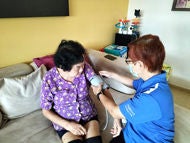What is - Cardiac Tamponade

Cardiac tamponade occurs when fluid builds up in the space between the outer sac covering the heart (pericardium) and the heart muscle (myocardium). The excess fluid puts pressure on the heart, causing the ventricles (large heart chambers) to be unable to expand fully. Less blood leaves the heart and blood pressure decreases.
Symptoms of Cardiac Tamponade
Symptoms of Cardiac Tamponade
- Sharp, stabbing chest pain that radiates to the neck, shoulder, back or abdomen
- Difficulty in breathing
- Low blood pressure
- Fainting and swelling of the abdomen
Cardiac Tamponade - Causes and Risk Factors
Cardiac tamponade can occur through chest trauma or pericarditis. It can also occur due to heart disease and heart attack.
Diagnosis of Cardiac Tamponade
The doctor will perform an initial evaluation and order some diagnostic tests to evaluate the condition of the patient.
Examples for initial diagnostic tests are:
Treatment for Cardiac Tamponade
Cardiac tamponade is an emergency condition and the excess fluid has to be drained immediately. Pericardiocentesis is a procedure that uses a needle to remove fluid from the pericardial sac.
For patients who have failed or are unsuitable for pericardiocentesis, surgical drainage may be required for the relief of pericardial tamponade. During this surgical procedure, part of the pericardium may be cut and removed if required.
Doctors may also prescribe medication to stabilise blood pressure after the procedure.
Contributed by
The information provided is not intended as medical advice. Terms of use. Information provided by SingHealth.
Get to know our doctors at SingHealth Hospitals in Singapore.
Get to know our doctors at SingHealth Hospitals in Singapore. here.




















